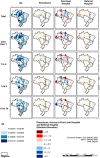Disparities in surgical care for children across Brazil: Use of geospatial analysis
- PMID: 31430312
- PMCID: PMC6701804
- DOI: 10.1371/journal.pone.0220959
Disparities in surgical care for children across Brazil: Use of geospatial analysis
Abstract
Background: Health systems for surgical care for children in low- and middle-income countries remain poorly understood. Our goal was to characterize the delivery of surgical care for children across Brazil and to identify associations between surgical resources and childhood mortality.
Methods: We performed a cross-sectional, ecological study to analyze surgical care for children in the public health system (Sistema Único de Saúde) across Brazil from 2010 to 2015. We collected data from several national databases, and used geospatial analysis (two-step floating catchment, Getis-Ord-Gi analysis, and geographically weighted regression) to explore relationships between infrastructure, workforce, access, procedure rate, under-5 mortality rate (U5MR), and perioperative mortality rate (POMR).
Results: A total of 246,769 surgical procedures were performed in 6,007 first level/ district hospitals and 491 referral hospitals across Brazil over the study period. The surgical workforce is distributed unevenly across the country, with 0.13-0.26 pediatric surgeons per 100,000 children in the poorer North, Northeast and Midwest regions, and 0.6-0.68 pediatric surgeons per 100,000 children in the wealthier South and Southeast regions. Hospital infrastructure, procedure rate, and access to care is also unequally distributed across the country, with increased resources in the South and Southeast compared to the Northeast, North, and Midwest. The U5MR varies widely across the country, although procedure-specific POMR is consistent across regions. Increased access to care is associated with lower U5MR across Brazil, and access to surgical care differs by geographic region independent of socioeconomic status.
Conclusions: There are wide disparities in surgical care for children across Brazil, with infrastructure, manpower, and resources distributed unevenly across the country. Access to surgical care is associated with improved U5MR independent of socioeconomic status. To address these disparities, policy should direct the allocation of surgical resources commensurate with local population needs.
Conflict of interest statement
The authors have declared that no competing interests exist.
Figures





References
-
- World Health Organization. WHA 68.15: Strengthening emergency and essential surgical care and anaesthesia as a component of universal health coverage (2015) 2015 [Available from: http://apps.who.int/gb/ebwha/pdf_files/WHA68/A68_R15-en.pdf.
-
- Goodman LF, St-Louis E, Yousef Y, Cheung M, Ure B, Ozgediz D, et al. The Global Initiative for Children's Surgery: Optimal Resources for Improving Care. Eur J Pediatr Surg. 2018;28(01):051–9. - PubMed
Publication types
MeSH terms
LinkOut - more resources
Full Text Sources
Medical

